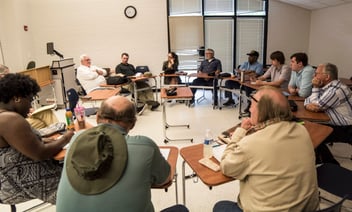Free service learning resource
When students engage in community service, everyone benefits.
Service learning improves academic outcomes and can even instill a life-long habit of social responsibility, all while creating a positive impact on shared communities.
Interested in incorporating service learning into your classroom? Learn the what, why, and how of service learning:
- What Is Service Learning?
- What Are the Benefits of Service Learning?
- Examples of Service Learning Projects
- How to Integrate Service Learning Into Your Curriculum
What Is Service Learning?
Service learning is an educational approach that connects experiential learning with community service or volunteerism. Through service learning, students engage in hands-on activities that address community needs.
The goal of service learning is to encourage civic engagement in students and support in-classroom learning, all while working to make shared communities happier, healthier places.
Service learning can be incorporated into a course curriculum of any discipline. Even better, children, teens, and adults of all ages can benefit from participating in service learning.
Want these service learning examples delivered to your inbox?
What Are the Benefits of Service Learning?
Learners often participate in service learning when they're looking to fulfill school requirements, but the benefits are much more than just a checkmark on their transcripts…
Why Is Service Learning Important for Students?
Participating in service learning can help students hone skills and knowledge, develop essential habits like empathy, and make a difference in their communities.
Students can learn the benefits of volunteering through service learning and are more likely to become civically engaged adults.
Service learning provides opportunities for:
- Personal and professional growth
- Leadership development
- Life-long civic engagement
- Career exploration
- Social and emotional learning
Finally, service learning is great for communities. Students are creative, enthusiastic agents of change that can offer a helping hand to community organizations and nonprofits. Projects can be tailored to meet the needs of various organizations or communities, including educational initiatives, environmental restoration projects, community-wide fundraisers, and more.
Download free service learning activities!
How Schools Benefit From Service Learning
Educational institutions—from elementary schools to universities—also benefit from incorporating service learning into their ethos.
A service learning framework can help bolster lessons in the classroom, creating a more enriching experience for students. It’s also shown to improve students’ academic outcomes and strengthen faculty-student relationships.
Service Learning Examples & Projects
There are many ways to incorporate service learning into a curriculum, but the goal is always the same: to support community initiatives and projects in meaningful ways to better the lives of others.
Students can provide direct service opportunities that impact community members directly; they can also get involved in other ways like advocacy, research, and community organizing.
Here are some great ideas for service learning projects:
- Community Space Clean-Up - Beautify public spaces, like the local park or community center. This is a popular project idea for young volunteers and teaches them about responsibility and teamwork.
- Care Home Visits - Partner with a local nursing or care home and spend time with the residents. Students can learn about different cultures and generations while bringing joy to the residents.
- Serve Meals - Partner with a local food bank or shelter to prepare and serve meals while students learn empathy.
- Awareness Campaign - Students research an important social issue and create an awareness campaign. For example, your budding climate activists may create a campaign to teach other students about the effects of climate change.
- Community Garden - Students create and maintain a community garden, learning important lessons in science while developing real-world skills.
- Citizen Science - Create project-based learning opportunities with science lessons that benefit communities. Check out PBS’ Citizen Science database curated especially for children. For older students, you can visit the national Citizen Science website chock-full of exciting opportunities to work with federal agencies like NASA and the Forest Service.
How to Integrate Service Learning Into the Curriculum
For the best student and community outcomes, service learning should be intentional and meaningful.
So, how do you go about integrating service learning into your curriculum? Here are some tips:
- Choose purposeful activities that align with the course topic and objectives. When selecting the best service project for your students, make sure it serves a real need and speaks to the core material of the course.
- Create realistic expectations. Don't expect too much from your students; learning through service can require extra time and effort. Be understanding of their time constraints while pushing them to challenge themselves and learn more.
- Provide valuable reflection opportunities. Reflection is an important part of learning through service. Be sure to provide activities or prompts encouraging your students to reflect on their experience and think critically about the material they've covered.
- Connect theory to practice. Through service, your students can better connect theoretical knowledge with practical skills such as problem-solving, communication, leadership, and more. Activities should bridge the gap between classroom learning and experiential learning.
What might service learning look like in practice?
Service learning programs should invite students to practice various skills and habits. For example, young students may practice their reading skills and confidence by reading aloud to older adults at a local nursing home.
Or, they might participate in an ocean cleanup while learning more about the effects of plastics on marine life in the classroom.
Students who participate in service learning become more skilled at interpreting and implementing what they have learned as it encourages them to think outside the conventional parameters of academic study.
Join 20,000+ Volunteer Leaders
Sign up for our Newsletter - Get fresh articles, guides, and webinars to help grow your volunteer program delivered to your inbox.
"The best free resources available for Volunteer Managers!" - Beth P.
Common Service Learning Challenges (and How to Address Them)
While the benefits of service learning certainly outweigh the challenges, it’s important to be aware of these challenges before implementing your program.
These are the most common service-learning pitfalls, along with practical guidance for avoiding them:
- Students don’t have a clear understanding of the project’s purpose. Students must have an understanding of the goals and purpose of their service learning project to fully appreciate its impact. Work with students to set goals and intended outcomes for the project. Then, invite reflection throughout the process so students take the time to understand the real-world implications of their task.
- The project doesn’t address real community needs. Some service-learning programs prioritize the needs of students over the needs of the community. Service projects should be a balancing act between addressing genuine needs and creating an enriching learning experience for students. Therefore, service learning programs benefit by partnering with community-based organizations that have a deep understanding of the community’s needs.
- Students don’t have enough support. It’s not enough to place students in service learning projects. To ensure everyone gets the most out of the experience, students should be supervised, supported, and given adequate resources to succeed in their roles.
Preparing and communicating a service learning planning and curriculum will help ensure that students understand the goals and intended outcomes of the project.
There are endless possibilities for service learning projects, and the best part is that they can be tailored to fit any age group or interest. Together, your classroom and your community will enjoy the benefits of service learning!
Don't forget your FREE service learning activity examples!
Service learning can be a great way for students to get more out of their educational experiences. Help your students learn new skills, develop essential life-long habits, and make a difference in their community with a thoughtful service learning curriculum.
Hundreds of educational institutions rely on Get Connected to help them manage their service-learning programs. Get in touch with us to learn more about our service learning software for optimizing your service learning program.

![Feature Image for [Planning Calendar + Templates] Everything You Need to Prepare for Volunteer Month](https://www.galaxydigital.com/hs-fs/hubfs/pexels-christina-morillo-1181533.jpg?width=352&name=pexels-christina-morillo-1181533.jpg)



